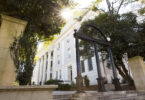Athens, Ga. – An international team of American and Brazilian researchers led by a University of Georgia scientist has been awarded more than $2.4 million by the Gordon and Betty Moore Foundation to investigate organic matter and nutrients flowing from the Amazon River into the adjacent Atlantic Ocean.
The project-dubbed River-Ocean Continuum of the Amazon-will study the lower reach of the river and its expansive offshore plume across a distance of more than 1000 miles. The grant will support sampling efforts in the region and the creation of mathematical models to help show how climate-influenced phenomena, including some natural disasters like floods and drought, might affect the global carbon dioxide balance and projections of climate change.
Led by Patricia Yager, associate professor of marine sciences in the UGA Franklin College of Arts and Sciences, ROCA brings together oceanographers and river scientists from 12 different institutions. The uncommon partnership will measure the carbon, nutrients, microorganisms, and other elements present in the Amazon River from 800 kilometers (almost 500 miles) inland to a similar distance offshore.
The award builds on an oceanographic project named ANACONDAS (for Amazon iNfluence on the Atlantic: CarbOn export from Nitrogen fixation by DiAtom Symbioses). ANACONDAS, also led by Yager, will investigate an unusual plankton bloom in the offshore river plume and how it impacts the carbon and nutrient cycles of the tropical Atlantic Ocean.
“If the Amazonian rainforest is ‘the lungs of the Earth,’ then the river and its plume are the breath,” said Yager. “The Amazon carbon cycle-the transfer of organic matter and other forms of carbon-doesn’t stop at the shoreline. The river and ocean must be viewed as a continuum rather than separate entities.”
The Amazon, the world’s largest river, contributes approximately 20 percent of the Earth’s river discharge into the ocean. The resulting plume extends for hundreds of miles beyond the coast of Brazil.
“From the perspective of the ocean carbon cycle, the influence of large tropical rivers is huge,” said Yager. “The river’s effect on the ocean, however, depends not only on the river water, but what the river carries and how those components are modified during transit.”
Previous work by Yager and others showed that microorganisms in the river plume could be used to gauge levels of nitrogen, carbon, iron, silica and phosphorus in the ecosystem. Over the next two years, these indicators will be measured at numerous points along the continuum between the lower reach of the river and the ocean to assess what happens when one of the world’s largest sources of freshwater meets the Atlantic Ocean.
Researchers will then develop a carbon cycle model that will link the upriver microbial system with the offshore plume. They will describe variations in how aquatic microbes respond to changes in the water by analyzing the microbial community composition and activity to see how much carbon and other elements are being taken up by various types of these tiny organisms.
“We have known for a long time that the world’s oceans help to sequester carbon from the atmosphere, which has helped to mitigate the effects of climate change,” said Yager. “We expect that the models we develop will give us a basis to better explain those effects, including changes in weather patterns, changes to the ecosystem, and possibly even greater ability to predict the effects of climate-related natural disasters like floods and drought.” In accordance with the information-sharing philosophy of the Moore Foundation, all data will be made widely available.
Besides Yager, ROCA researchers include Mary Ann Moran, Patricia Medeiros, and Adrian Burd from the University of Georgia School of Marine Programs. They are joined by Victoria Coles, Byron Crump, and Raleigh Hood of the University of Maryland Center for Environmental Science; Jeff Richey, University of Washington School of Oceanography; John Paul, University of South Florida College of Marine Science; Alex Krusche, Centro de Energia Nuclear na Agricultura, University of São Paulo, Piracicaba, Brazil; and Marcelo Fernandes,Centro de Pesquisa Agropecuária dos Tabuleiros Costeiros, Empresa Brasileira de Pesquisa Agropecuária, Aracaju, Brazil.
The project also will connect with an existing education and river sampling network (Rede Beija Rio) composed of Brazilian scientists from the Instituto Nacional de Pesquisas Espaciais (São José dos Campos), Universidade Estadual Paulista (São Vicente), Museu Paraense Emílio Goeldi (Belém), the Instituto de Pesquisas Científicas e Tecnológicas do Estado do Amapá (Macapá), the Universidade Federal do Pará (Belém), and Universidade do Estado do Pará (Belém).
“We are excited about the scope and potential impact of the project,” said Krusche. “This is a wonderful opportunity to connect river and ocean processes and how they relate to climate change.”
The Gordon and Betty Moore Foundation, established in 2000, seeks to advance environmental conservation and scientific research around the world and improve the quality of life in the San Francisco Bay Area and beyond. The foundation’s Marine Microbiology Initiative supports discovery and dissemination of scientific findings and technological developments in the fields of marine microbiology and microbial ecology. Marine microbial ecosystems are critical to understand because they are key contributorsto the Earth’s health and productivity. For more information, see www.moore.org.







